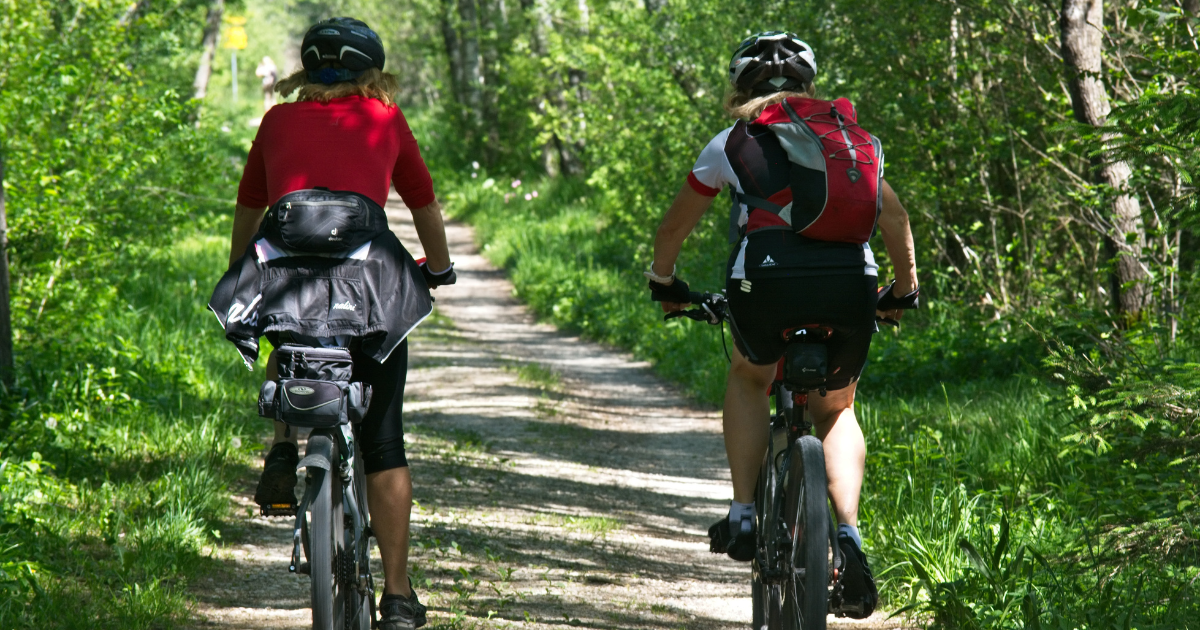Spring Cycling Safety: 8 Tips for an Injury-Free Ride
 As soon as spring hits, Wisconsinites head outdoors. For some, that means hopping on a bike and enjoying the warm breeze, sunshine, and blooming flowers along many of Wisconsin’s beautiful trails. While biking this spring and summer should be smooth sailing, it’s important to implement a few cycling safety steps before heading out. Cycling accidents are prime opportunities for orthopedic injuries and can lead to long-term issues.
As soon as spring hits, Wisconsinites head outdoors. For some, that means hopping on a bike and enjoying the warm breeze, sunshine, and blooming flowers along many of Wisconsin’s beautiful trails. While biking this spring and summer should be smooth sailing, it’s important to implement a few cycling safety steps before heading out. Cycling accidents are prime opportunities for orthopedic injuries and can lead to long-term issues.
Orthopedic Hospital of Wisconsin physical therapist Amy Sordahl, PT, DPT, of Cedarburg Physical Therapy, lays out her top 8 tips for cycling safety that can help you stay injury-free this spring and summer.
-
Always Wear a Properly Fitting Helmet
Cycling safety begins with your gear. Your helmet should be snug but not overly tight. There should be less than one inch of movement from front to back and side to side. If the fit is “sloppy”, the helmet is too loose and will not protect you as much as a properly fitted helmet. The chin strap should be no less than 2 finger widths from your chin. If you need assistance with the fit of your helmet, your local bike store is happy to help.
-
 Get a Tune-Up
Get a Tune-Up
For most of us, our bikes have been sitting all winter long. Tires dry rot, brakes get stiff, cables lose integrity, chains rust, and more. Take your bike to the local bike shop for an easy tune-up before your first ride to ensure every piece of your machine is in working order.
-
Carry the Right Gear
You don’t have to look like a professional racer in the Tour de France, but you should head out with the right gear on any ride. Besides your helmet, you should wear bright-colored clothing, preferably reflective green or yellow. These are the easiest colors for motorists to see. If you don’t have supplies to change a flat tire (or the knowledge), carry your cell phone so that you can call for help if you have a mechanical issue or a blown tire.
All cycling jerseys have a pocket in the back just to hold essentials like your phone. If you are not wearing cycling clothing, invest in a pack or basket that will fit easily on your bike. Sunglasses are helpful to keep UV rays out of your eyes and to block the stray bug or bee from banging into your eyes and throwing off your balance. They also help to decrease glare on a sunny day so you can see obstacles in the road or on the trail.
-
Install a Light
Even if you don’t cycle in the early morning or evening hours, it is wise to carry a light. Both a front and a rear light are ideal. The rear light should be a flashing red light. This alerts motorists and allows them to see you better, even in the daytime hours. Just as daytime running lights in vehicles have become standard, so should your bike light.
-
Control Your Speed
If you ride on a multi-use trail (such as the interurban trail or bug line), the speed limit is 15 mph. With the increased popularity of e-bikes, this is becoming a significant issue on multi-use trails as it is quite easy to exceed this limit (there are proposals on the table to ban e-bikes from sidewalks and trails due to the speed riders are traveling and the dangers it imposes on all users). Do not ride faster than your skill level and be careful of turns, twists, railroad crossings, and other users. Do not follow the rider in front of you too closely and be able to brake at any time. Be in charge of your bike!
-
Follow Cycling Safety the Rules
While riding a bicycle, you must follow the same rules as a motorist. This means stopping at all stop signs, waiting for traffic to cross roads, using hand signals to identify when you are turning, etc. Cyclists and motorists must yield to pedestrians. Also, if you are on your bike, you are not considered a pedestrian when in a crosswalk, and the vehicles on the road should not stop for you. If you are walking your bike, you are now considered a pedestrian, and vehicles must stop for you while in the crosswalk.
You should never expect traffic to stop for you just because you are a cyclist. Also, sidewalks are for pedestrians and not cyclists. Exceptions include small children traveling at slow speeds who need extra protection. Remember, pedestrians always have the right of way (this includes people on horseback). If you approach someone walking or on a horse, let them know you are there, SLOW DOWN or STOP and wait for instructions from the horse rider to avoid spooking the horse. They have the right of way, so please respect that.
-
Beware of Road Hazards
Potholes, cracks in the trail, and railroad crossings can all cause significant damage to your bike – and you! Try to avoid potholes at all costs. With cracks in the trail or railroad crossings, you should try to cross at a 90-degree angle to prevent your tires from turning or getting caught in the tracks.
-
Enjoy the Ride
Cycling is not only a great form of exercise, but also an excellent way to get out and enjoy nature and the outdoors. It is meant to be enjoyed and not meant to be a race. Slow down and enjoy!
If you’ve experienced an orthopedic injury from a cycling accident or any other reason, our team of orthopedic specialists is here to help you get back on your bike. Call (414) 961-6800 or go online to request an appointment.

